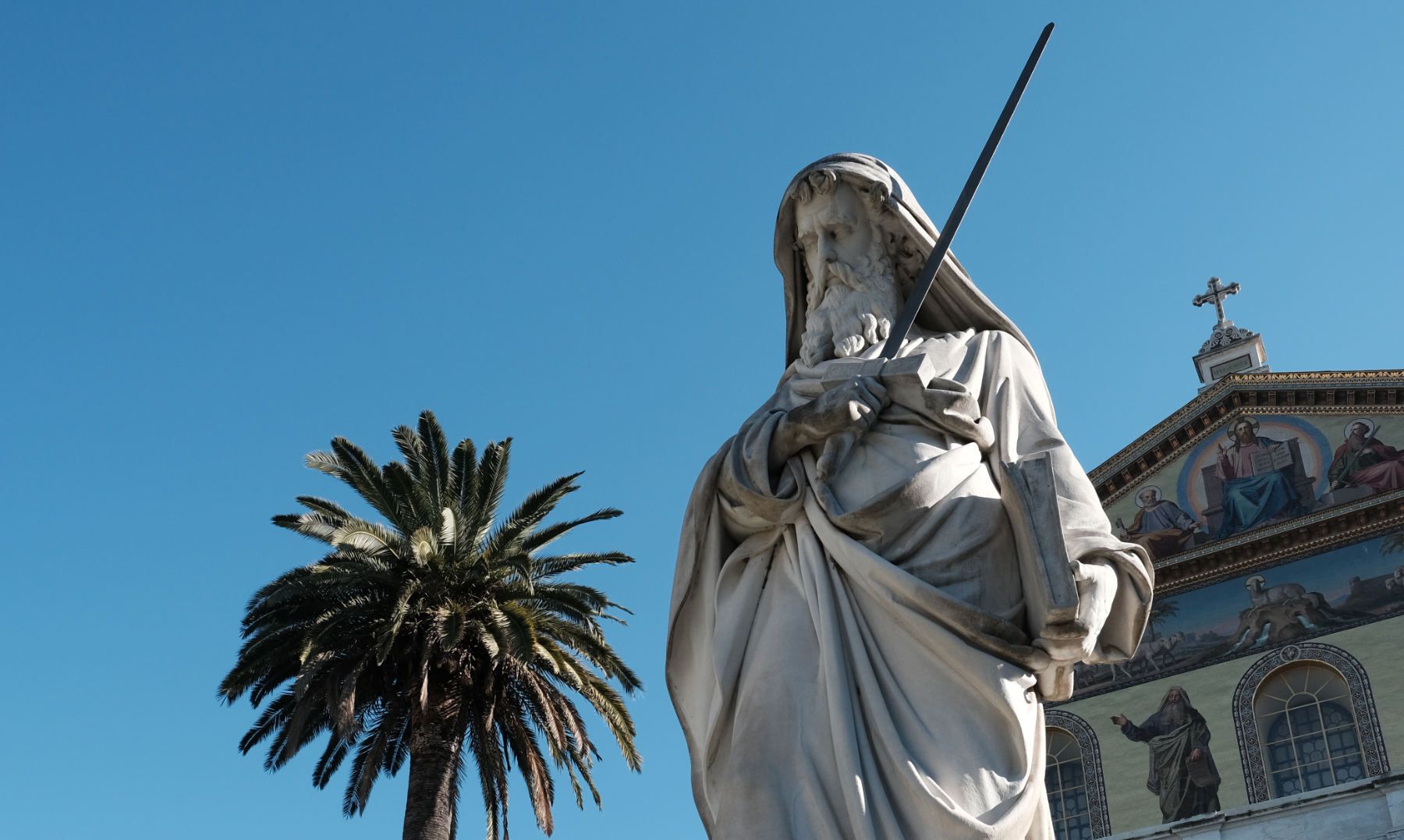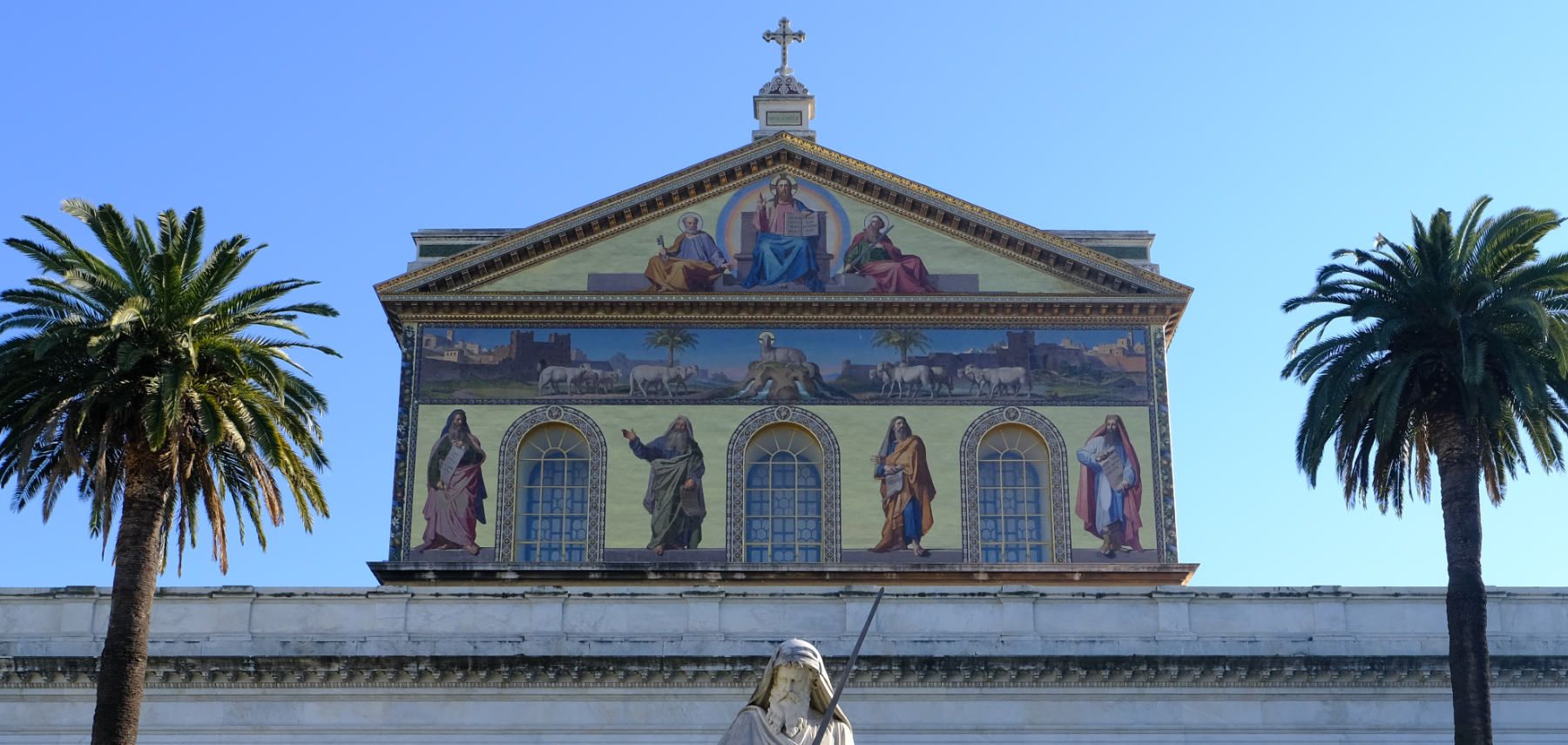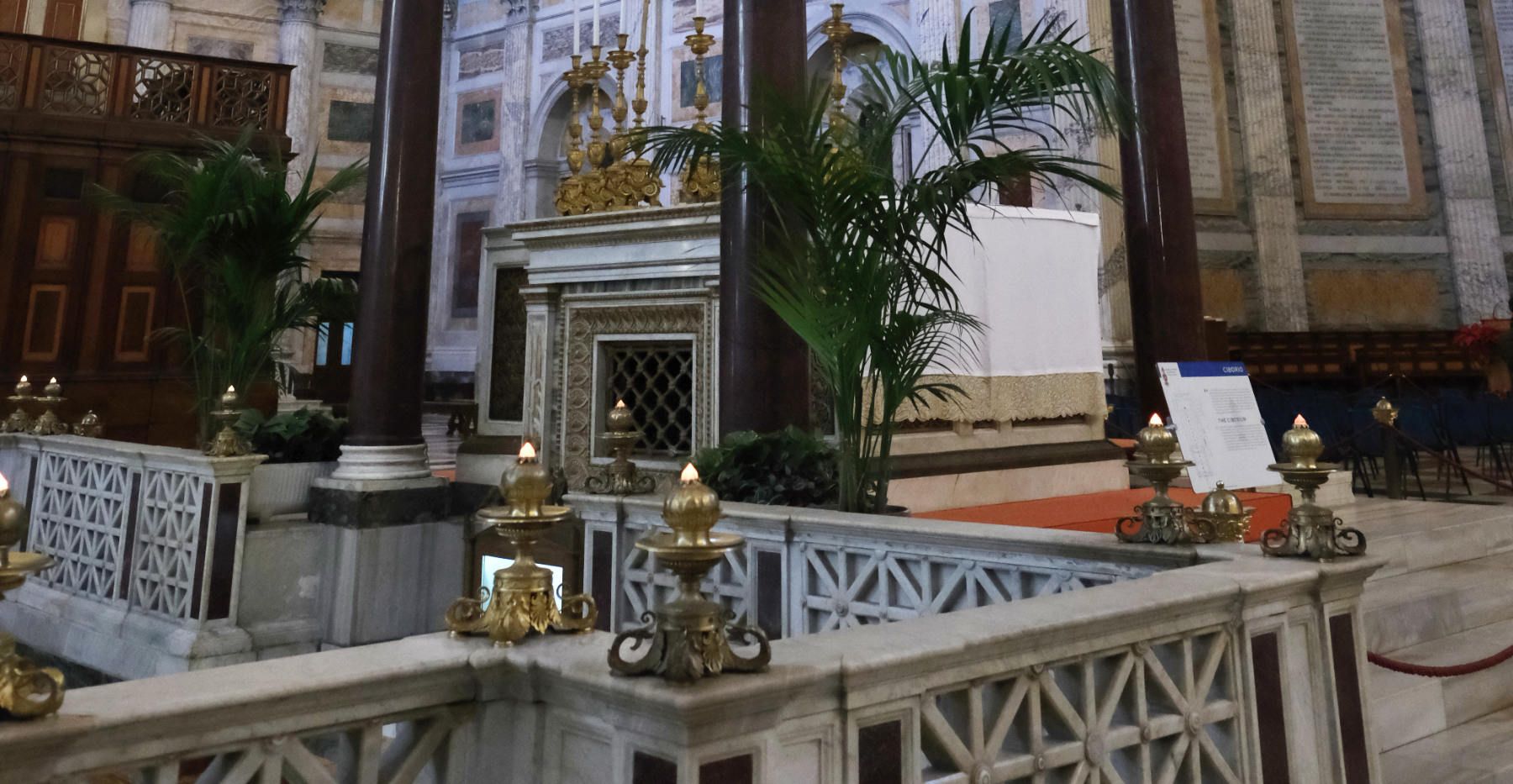
Facts
Built: 324 | Rebuilt: 1823–1854
Must-Sees
- Apse Mosaic: Christ the Pantocrator
- Triumphal Arch Mosaic: The Apocalypse of John
- Paintings of the Life of St. Paul (on the walls of the nave)
- Portraits of the Popes (from Peter to Francis)
Prayer Spots
- Tomb of St. Paul (under the main altar)
- You can gain a plenary indulgence in this Basilica. See the requirements.
St. Paul’s Statue

Date: circa 1850 | Artist: Giuseppe Obici
This statue, standing in the Quadriportico, represents St. Paul clasping the book of his epistles which proves him, as we read at the base of the statue, “a preacher of the Truth” and “a teacher of the Gentiles.”
His right hand holds a long sword for two reasons. First, he was beheaded by a sword, the instrument of his martyrdom. Second, the sword signifies the Word of God, of which Paul was a tireless preacher:
Take the helmet of salvation, and the sword of the Spirit, which is the word of God (Ephesians 6:17).
Mosaic: Façade

Date: 1854–1874 | Artist: Vatican School of Mosaics
The façade mosaic replaced a 13th-century mosaic by Cavallini which was destroyed by fire. In the lower section, we find the major prophets of the Old Testament: Isaiah, Jeremiah, Ezekiel, and Daniel. They symbolize the 4,000 years that preceded the coming of the Messiah.
The Sacrificial Lamb occupies the center of the middle section. Its death produced streams of water flowing to four quarters of the world. This is the redemption Christ offers to all nations. The city on the left is Bethlehem where Christ began his earthly life. He completed it in the city on the right, Jerusalem. The triumphal arch of St. Mary Major also features these two cities (albeit in reverse order).
At the summit, we see Christ enthroned, holding a book containing his words:
My sheep hear my voice … [and] I give them eternal life (John 10:27–28).
He is flanked by the two patrons of Rome, Peter and Paul. In the earlier 13th-century mosaic, Paul stood at Christ’s right. However, the current one inverts the saints’ position: now Peter occupies the place of honor at the right side of Christ. This modification echoes the proclamation of papal infallibility by the First Vatican Council (1870), four years prior to the completion of this façade. This is a salient example of how art reflects doctrine.
Portraits of All Popes
This Basilica boasts a series of 266 mosaic portraits depicting every pope from Peter to Francis. The portraits are arranged as a frieze that winds around the church, starting in the right transept and ending in the far right aisle.
Mosaic: Triumphal Arch

Date: 5th century
The triumphal arch honors St. Paul as the doctor mundi, the teacher of the world. At the center is Christ blessing us. He is surrounded by the living creatures representing the four evangelists and by the twenty-four elders in Revelation 4. On the left side of the arch, St. Paul points to his tomb under the altar. On the right side stands St. Peter.
St. Paul’s Tomb

Date: AD 67
In AD 61, Paul arrived in Rome to face judgment. He was beheaded in 67. His body was buried three kilometers away from where he was killed, in a burial area owned by a Christian woman named Lucina, which was already in use. Despite being a Christian, he was allowed to be buried in a Roman cemetery because he was a Roman citizen. His tomb soon became a place of worship and many people came to pray there, drawing strength to spread his message. A memorial was built on top of his tomb, where people continued to visit and pray during the first centuries of persecution.
Underneath the current Papal Altar, there is a marble tombstone that measures 2.12 meters by 1.27 meters and is located at a depth of 1.37 meters. The tombstone bears the Latin inscription “PAULO APOSTOLO MART” which means “Apostle Paul, Martyr.” The tombstone is situated on top of a large sarcophagus, which is 2.55 meters long, 1.25 meters wide, and 0.97 meters high. Recently, a large window-like opening was made just below the Papal Altar to allow the faithful to see the Apostle Paul's tomb.
Mosaic: Apse

Date: 13th century | Artist: Venetian Masters
The three half-circles at the top point to the Trinity. Christ the Pantocrator (the Almighty) blesses us with his right hand. His three upright fingers represent the three persons of the Trinity. The two joined fingers point to the union of the divine and human natures in him.
Christ is also presented as our Judge. The book he holds contains his words of judgment:
Come, you that are blessed by my Father, inherit the kingdom prepared for you from the foundation of the world (Matthew 25:34).
In this mosaic, Christ’s kingdom is presented in resemblance to Eden, as the abundance of fruited palm trees and animals suggests.
From left to right stand Sts. Luke, Paul, Peter, and Andrew. Luke, having written the Acts of the Apostles, is Paul’s biographer. Peter is depicted with his characteristic curly hair and holding the keys. Andrew is the first apostle called by Christ. Let us not miss the figure holding Christ’s right foot: Pope Honorius III (1216–1227), who commissioned the mosaic.
The entire mosaic, especially the letters on the scrolls, highlights Christ’s divinity. Luke’s scroll contains his own words:
Saul became increasingly more powerful and confounded the Jews who lived in Damascus by proving that Jesus was the Messiah (Acts 9:22).
The scroll of Paul reads:
at the name of Jesus every knee should bend, in heaven and on earth and under the earth (Philippians 2:10).
Peter’s contains his confession:
You are the Messiah, the Son of the living God (Matthew 16:16).
Finally, Andrew’s reads:
Blessed Andrew, while hanging on the cross, prayed to the Lord Jesus Christ.
At the center of the lower band, we find a jeweled cross and the instruments of Christ’s passion: the crown of thorns, Longinus’s spear, a chalice with three nails, and a sponge. The jeweled cross is flanked by two angels and ten apostles plus Barnabas (substituting Peter) and Mark (substituting Andrew).